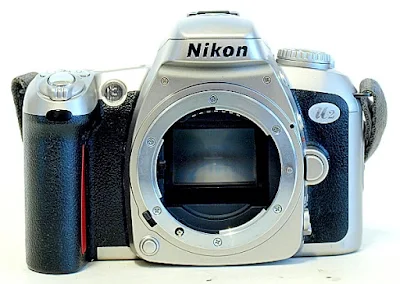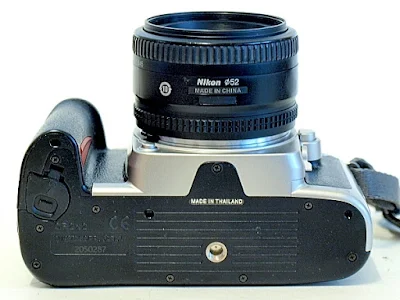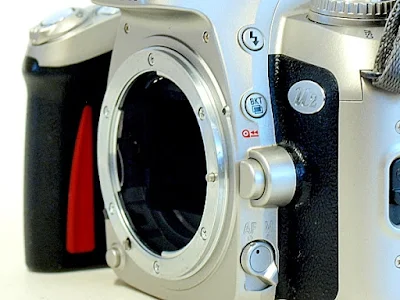The Vintage Enthusiast: An advanced and full-featured lightweight autofocus 35mm SLR film camera from Nikon, the last of the breed.
The Nikon U2 (N75 in the US and F75 in Europe), the last consumer-level autofocus 35mm SLR film camera manufactured by Nikon, was launched in 2003, replacing the N65 which was introduced a couple of years earlier. Although a compact and lightweight model, the U2 is actually a very advanced and capable camera developed to incorporate features and innovations that make the F5, F100, and F80 the top 35mm SLR film cameras of their genre.
With a bodyweight of only 380/385 grams, the U2 / N75 / F75 is fitted with an excellent electronically-controlled vertical-travel focal-plane shutter with a speed range from 30 to 1/2000 second, accepts film ISO speeds from 25 to 5000 (set by DX coding only), and comes with a veritable selection of automated program and manual shooting modes, remote control sensor, and built-in Speedlight.
Metering is by a 25-segment Matrix metering pattern with five user control autofocus sensors via a three-way switch plus a jog dial on the film back. Another advantage to have is that the AF system of the U2 / N775 / F75 works with every AF, VR, AF-I, and AF-S lens ever made by Nikon, as well as earlier manual focus lenses through its in-focus confirmation dot system.
Selection of exposure modes available on the camera includes Auto Multi-Program [P], Shutter-Priority Auto [S], Aperture-Priority Auto [A], and Manual [M], with Point-and-Shoot options including AUTO, Portrait, Landscape, Close-Up, Sports, and Night Portrait shooting.
Nikon N75 Video Manual
One of the last consumer grade SLRs. This camera from Nikon reminds me a lot of modern cameras and the good and bad that comes with that. . . . .
The launch of the U2, however, was rather inconspicuous as it was already a year into the introduction of the digital D100 (2002) and other DSLR cameras, which were then trending as the beginning of the new norm in SLR photography. Production of the U2 / N75 / F75 was discontinued in 2006.
Basic Camera Features
More commonly seen in the chrome version, with the occasional all-black popping up here and there, the U2 was part of the trend of low-cost plastic-bodied fully automatic 35mm AF SLR cameras of the 90s. The camera has a simple ergonomic design with features that include a simple and easy-to-use function dial and an LCD control panel. When powered to function automatically, the camera is light enough to operate with one hand and is almost the perfect point-and-shoot.
The veritable control center of the camera, the top panel, which is rather clean and simple, is populated by a control dial on the left, the LCD panel on the right, a camel hump housing the power and shutter button, and a couple of toggle switches for LCD illumination and Aperture/Exposure Compensation/Film Rewind functions. The built-in Speedlight sits on top of the pentaprism.
The control dial houses the Auto and PSAM mode selection settings and the Vari-Program selection for Portrait, Landscape, Close-Up, Sports, and Night Portrait shooting modes. A small selection lever sticks out of the control dial for Film Advance (Single, Continuous) mode and CSM mode selection. The Vari-Program modes will let the camera determine the precise aperture and shutter speed values automatically.
The front of the camera houses the proportionally huge lens mount housing, which almost fills the whole front of the diminutive body. The housing is fitted with a depth of field preview button on its lower left, the lens release lock on the right of the mount, and vertically, the Flash Release Lock/Flash Sync Mode button, Auto Exposure Bracketing/Multiple Exposure/FIlm Rewind button, and focus mode selector (AF, MF) switch.
The back of the camera carries the AE-L switch, the Command dial for the LCD panel info, and on the film back itself, the AF Area Selector. The Quartz Date version of the camera will have the QD selection and setting gizmos located on the film back itself, partly integrated with the AF selector dial. The bottom plate is plain except for the tripod mount, and the 2CR2 batteries chamber cover.
The bottom plate is plain except for the tripod mount, and the 2CR2 batteries chamber cover.
Film Loading and Rewind
Film loading on the U2 is motorized. For loading, the film must be tensioned properly, with any excess pushed back into the film canister, the film end stretched across the film box to the red index mark on the take-up spool side, and the film back closed.
The camera uses the preload system where the film roll is first advanced to the last frame, indicated by the numeral 36 on the LCD display panel, and is wound back into the canister as you take the shots. The logic here is that if there is a mishap and the back is opened accidentally, all is not lost as the shots that you have taken have been rewound into the film canister.
This system does away with the need to do film rewind as well.
LCD Panel Info
The right LCD panel on the top plate of the camera is the command control, which is firstly a numbered menu system display with which you customize the camera's setting and in shooting mode, a display of all relevant shooting information. This includes the number of shots taken (count down, number of shots remaining), shutter speed, aperture, metering mode, and flash settings.
To customize the camera's setting, first, rotate the Custom Setting Selector on the top left of the camera to CSM, and use the Command Dial at the top back of the camera to run down the menu list, which ranges from 1 for the Beep Sound, to 12 for AF Assist Illuminator activation.
Viewfinder Readout
The viewfinder, fitted with a B-type Clear Matte Screen V with focus brackets, providing approximately 89% frame coverage, displays a central 12mm reference circle for Center-Weighted Metering, five focus area indicators, and a couple of icons for film status and battery power indicator.
An LCD bar below the screen displays the Focus Indicator, Shutter Speed setting, Lens Aperture opening, Exposure Compensation value, and flash-ready light.
Exposure Compensation, which is available in PSA and Vari-Program modes is adjustable by pressing the Auto Exposure Bracketing/Multiple Exposure/Film Rewind button located on the left of the lens mount (just above the Lens Release lock) and rotating the Control Dial to the amount required.
(Note: Page number indicators on the illustrations above refer to the pages where the info is located in the Instruction booklet, which you can download from Buktus.org.)
AF Area Mode Selection
Use the Green Box genie of the AF Mode Mode selector, located on the film back itself, to let the U2 selectively pick the area sensor, and inform you of the selection by lighting up the relevant rectangle in the finder, or setting the selector to the middle dot to use only the middle sensor. The lower crosshair setting lets you select which sensor to use with the compass-point thumb-control of the rotary switch.
Lens Compatibility
As mentioned earlier, the U2 is completely compatible with every AF, VR, AF-I, and AF-S lens and flash system made by Nikon. Manual focus lenses can only be used in the Manual shooting mode, with an in-focus confirmation dot, but with no metering.
Battery
The U2 requires a pair of CR2 batteries to operate, rated for 40 36-exposure rolls without flash, or 12 rolls with flash half the time.
Camera Body Weight
The Nikon camera's body weight is a petite 380 grams for the standard version, while the QD version will weigh 385 grams.
Using the Camera
Aside from the assumed feeling of the flimsiness of the plastic body, which dissipates once you get into the swing of having a lens attached, the U2 is a great camera and a pleasure to use. You will have access to almost all the functions that you can find on your current DSLR body in a very compact and lightweight body, managed via dials and mode settings that are equally easy to master./p>
To top it all, the U2's compatibility with everything of Nikon's AF, AF-S, VR, and all the flash systems since 20 years ago, the straightforward, easy handling, very well damped, and smooth operation of the U2 makes it a truly incredible and affordable introductory film camera for the new enthusiast. It could also very well be a film backup camera for digital enthusiasts who are keen to have a look back at film photography.
If you already have access or you are using any or all of the lenses mentioned, the cost of adding the U2, or the N75 and F75 body to your arsenal, as are frequently listed and are easily available on the auction market, normally priced for a song, almost negligible.























No comments:
Post a Comment